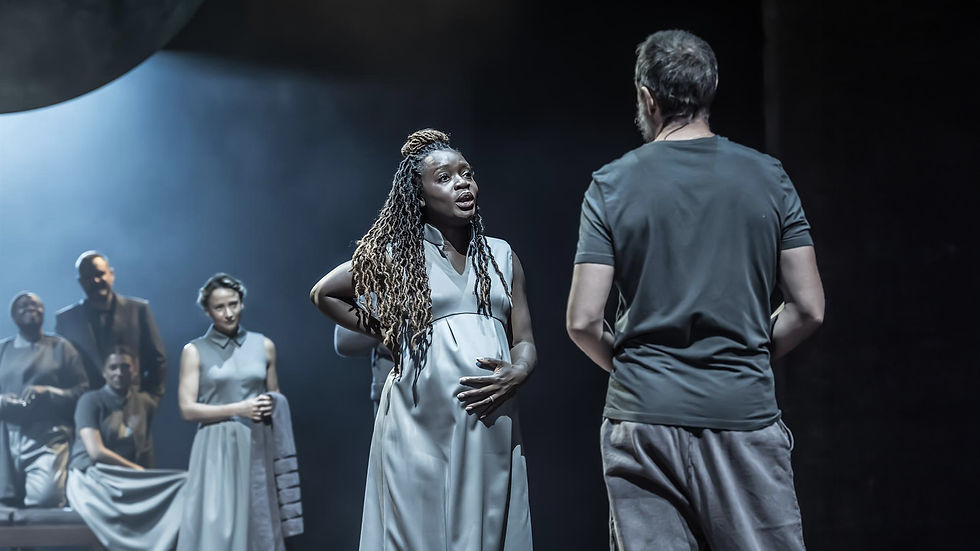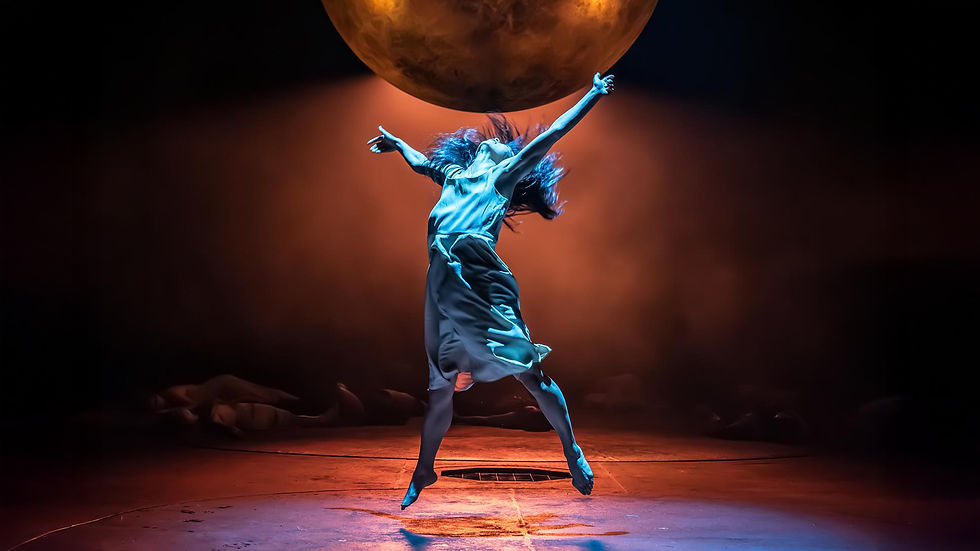The Winter's Tale - RSC Review
- Thomas Levi

- Aug 2, 2025
- 4 min read
★★★☆☆
A cinematic marvel that dazzles the eye but slightly dulls the heart?
The Royal Shakespeare Company’s 2025 revival of The Winter’s Tale is one of those rare Shakespeare productions you appreciate before you understand. Directed by Yaël Farber, it immerses you in a visual feast of shifting worlds and emotional extremes. From the oppressive court of Sicilia to a sun-drenched Bohemia, the staging is spectacular. But does all that slick design serve the story, or overshadow it?

The Winter’s Tale is a story of jealousy, loss, and redemption. When King Leontes of Sicilia becomes irrationally convinced that his wife, Hermione, is having an affair with his best friend, King Polixenes of Bohemia, this sets off a chain of devastating consequences, including the death of his son and the abandonment of his newborn daughter. Sixteen years later, truth, love, and time begin to heal old wounds, leading to one of Shakespeare’s most miraculous and moving endings.
The production values here are top‑tier. Soutra Gilmour’s design is cinematic, with two revolving stages, a raised platform, a fire pit, and a shallow pool encircling the front of the stage, all used with understated precision rather than feeling gimmicky. The visual transition from the oppressive grey‑scale of Sicilia, accentuated by stark white lighting and the constant glare of an illuminated moon, to the vibrant, sunlit rituals of Bohemia is dramatic and compelling. These elements evoke an atmosphere that feels striking and memorable.
However, Sicilia’s visuals are quite exhausting to watch for long periods. The white light, matching grey costumes, and the luminescent globe risk giving scenes a flatness that not only drains emotions, but the eye struggles to focus. The monochrome aesthetic makes it hard to distinguish Hermione from her court or Leontes from any other nobleman. These Important, high-status characters blend into the background, complicating understanding for anyone not already familiar with the play. In other words, it feels less like theatre and more like homework for newcomers.

Trevor Fox, cast as both Autolycus and Time, makes a strong early impression; his sardonic, free‑roaming presence skirts the edge between observer and trickster. His Act One moments feel purposeful and mysterious. Unfortunately, by Act Two, his moments carry on too long, and what began as engaging quickly becomes tiresome — a shift tied to the script’s alterations oppose to the actors ability.
At the centre, Bertie Carvel’s Leontes is commanding. He brings intensity and psychological realism as the paranoid king, transitioning convincingly from regal to rage‑ridden. Madeline Appiah (Hermione) and Aïcha Kossoko (Paulina) are the emotional pillars. Appiah delivers dignity and resilience, particularly in her courtroom scenes, while Kossoko’s Paulina is fierce, grounded and unforgettable.

The real standouts of this production is the music. With musicians on stage throughout, the score blended seamlessly into the world of the play, often adding to the living tableaux created by Farber’s direction. The use of dynamics was particularly powerful, swelling from gentle, slow-attack strings that tugged at the heart to rhythmic, percussive scores that drove the energy forward. In Bohemia, the music took on a raw, almost tribal feel that suited the earthiness of the world and helped build the contrast between the two realms.
That said, the decision to use microphones, presumably to compete with the volume of the soundscape, was a misstep. At a venue like the RSC, where vocal naturalness is part of its charm, hearing the mic rustle during physical scenes or lines drop out due to mistimed cues was jarring. It broke the spell, disrupted the immersion, and felt like a piece of technology we didn’t need.
Among the cast, several performances stood out for their clarity and artistry. Chihiro Kawasaki brought energy to the stage with moments of interpretive dance that felt like emotional punctuation. Rhianna Compton’s vocals had an almost sacred quality to the Bohemia scenes. Lewis Bowes made a strong RSC debut as Florizel, bringing charm and sincerity to the role. At the same time, Amelda Brown and Ryan Duval delivered warm, grounded performances as the Shepherdess and Clown. Raphael Sowole, as Camillo, impressed with his commanding voice and crisp delivery; every line felt measured and deliberate, anchoring the scenes he appeared in.

However, one key moment feels underplayed: Leontes's learning that Perdita is his daughter lacks dramatic weight. The audience is aware of what’s coming long before he is, and the play seems to glide over that recognition rather than let it erupt. While the final reunion is touching, it doesn’t quite deliver the emotional catharsis one might expect for Shakespeare’s moment of reconciliation.
Overall, The Winter’s Tale at the RSC is supremely watchable and undeniably cinematic. It’s high spectacle, all gleaming under one enormous moon. But while every visual choice feels considered, some of them leave the human story in a grey shadow. Still, this production wraps you in its design and performances so eloquently that you'll likely leave talking more about what you saw than what you felt.





















































Comments